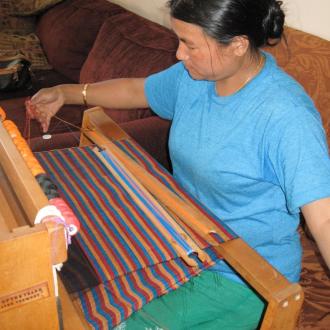
Tirtha Subba is an expert floor loom weaver of textiles in shades of blue, gold-orange, and red – some of the same thread colors she used in her weaving work in the craft shop in the refugee camp in Nepal before she came to the United States as an officially vetted refugee about eight years ago (Rodgers and Umunna 2017, Path to Empowerment, pp. 17-18). Tirtha and her relatives had arrived in the camp many years before after being forced to flee their homes and farm businesses in Bhutan, forced out by the Bhutanese national government. The latter had deemed the Nepali-speaking Bhutanese to be “outsiders” despite the fact that they had lived in Bhutan for hundreds of years. In resettlement in the U.S. they are often referred to as Nepali-speaking Bhutanese refugees. They live now in many regions of the U.S. and are one of the largest forced migrant communities in Worcester, MA. Many are now U.S. citizens or on a path to that status, after residing in the U.S. for at least five years.
When they first arrived in Massachusetts some of the refugees from Bhutan were largely confined to manual labor jobs in warehouses or distribution centers but now a considerable number of them are moving into more skilled jobs. Some, like Tirtha, took English classes for years in the refugee camps; that has helped them to move into more highly paid employment in Massachusetts.
Tirtha’s weavings in the refugee camp were constrained by the craft house staff as to thread type, yarn color, and motif structure. This was in large part because the camp staff wanted to sell the finished cloth to Nepalese markets and companies to be cut up and re-fashioned into men’s hats to re-sell. The hats were part of the Nepalese national costume for men.
When Tirtha transferred her weaving skills to Worcester and began to collaborate with RAW, that organization’s co-directors told weavers that they now had wide latitude to change colors and patterns for their craftwork if they wished. It is notable that Tirtha decided to stay with the cloth conventions she had learned in the refugee camp craft house. Her textiles are approximately 36 to 48 inches wide and about 72 inches long. They can be used as wall hangings or decorative table runners. The colors are jewel-toned and that helps in sales.
It is interesting that Tirtha did not expand outward into new hues or patterns once in Worcester. Perhaps this was in part because she may have considered floor loom weaving as a stop gap measure to earn ready cash for a few years early in her resettlement. She has now moved on to full-time work in a job outside the home and no longer weaves to any extent. With her English skills she had a relatively clear path to lucrative employment in the mainstream Massachusetts economy.
Older women weavers in their sixties, by contrast, are often more limited in their English fluency and tend to be still mired in manual labor jobs if they work outside the home (for instance, some do seasonal work at a local plant and flower nursery). But, their weaving work is vibrantly creative and deeply innovative, with new motifs and threads choices through their partnerships with RAW. Textile hand-manufacture by refugee artisans in Worcester does seem to be strongly shaped by economic circumstance. For some, artisanal work is a temporary, time-consuming but low-pay part-time occupation. For others it is a rewarding artistic endeavor with profound ties to heritage.
